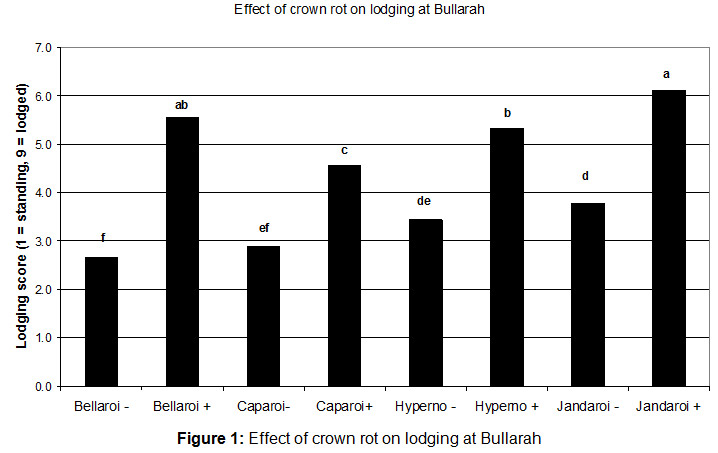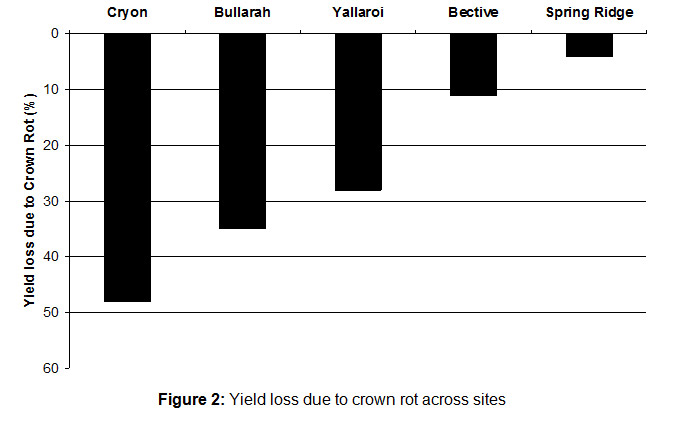IMPACT OF PLANT POPULATION ON CROWN ROT IN DURUM WHEAT
| Date: 24 Sep 2010

Background
Durum wheat remains the most susceptible of the winter cereal crops to crown rot infection and yield loss. Management strategies such as rotation, fallow/stubble management, inter-row sowing and planting time have been investigated previously with demonstrated benefits. However, little work has focused on the effect of varying plant population and the carryover effect on soil water available for the critical crop development stages of flowering and grain fill which dictates the extent of yield loss to crown rot. In 2009, five replicated trials were conducted across northern NSW, using the four main durum varieties in the region to assess if the impact of crown rot could be minimised by varying plant populations and variety selection.
How was it done?
Five replicated trials were sown using four durum varieties, (EGA Bellaroi , Jandaroi , Caparoi and Hyperno ). Three plant populations (60, 120 and 180 plants/m2) were targeted. Plots of each variety were either un-inoculated or inoculated with sterilised durum grain colonised by the crown rot fungus at a rate of 2g/m of row, this represents a very high crown rot background.
The five trials were located at Cryon, Bullarah, Yallaroi, Spring Ridge and Bective. There were three replicates of each treatment. Each site was soil cored to 1.2 m pre-sowing to establish the starting soil water levels and each plot was soil cored post flowering to measure variations in soil water available for the grain fill period. Plant, tiller and head number per m2 were measured in each plot. In addition whitehead counts and lodging scores were taken where applicable. Hand samples were removed from each plot at physiological maturity for pathology assessment while yield and grain quality were obtained from samples collected using a small plot harvester. Sites were selected based on previous crop rotation in an attempt to minimise the background levels of crown rot in each trial.
Effect on establishment
Crown rot reduced plant establishment at all sites but the individual durum varieties and target plant populations appeared to influence the extent of establishment losses. Caparoi had minimal establishment losses from crown rot across all sites (0-6% loss), with plant establishment across populations remaining very similar between inoculated and un-inoculated plots. Jandaroi , also generally suffered low establishment losses from crown rot of between 2-5%. In contrast, significant reductions in established plant populations were found due to the addition of crown rot in EGA Bellaroi and Hyperno , with losses of between 12-20% (Av. 16%) and 7-30% (Av. 22%), respectively. There was also a trend for establishment losses from crown rot to be greater in these two varieties under higher plant populations.
Hence, when sowing into paddocks with high levels of crown rot inoculum plant establishment may be reduced considerably due to seedling death before emergence. This perhaps suggests the potential to increase planting rates with EGA Bellaroi and Hyperno to compensate for establishment losses from crown rot. However, given their extreme susceptibility, avoiding sowing durum into paddocks known to have high crown rot levels is advisable.
Effect on tillering and head numbers
Tiller and head numbers were reduced in the presence of crown rot in all varieties at each of the five sites. Genotypic differences in tiller production exist between the durum varieties. Caparoi is a higher tillering variety, achieving more tillers/m2 than the other varieties, whilst Jandaroi appears to be a lower tillering variety, with these varietal differences being consistent across sites.
Jandaroi produced the highest number of heads/m2, even though it had lower tiller numbers, demonstrating it produced a lower proportion of non-productive tillers. Across sites, a high number of tillers were lost between stem elongation and flowering during the 2009 season. On average 40% of tillers were dropped at the 60 and 120 plant populations, while over 50% of tillers were dropped at the higher population of 180 plants/m2. Hence some resources such as soil water were used producing tillers which did not result in yield.
Whitehead expression
Generally inoculated plots had higher whitehead expression than the un-inoculated plots. At all sites there was no consistent trend between varieties to differ in the extent of whitehead formation. At Bullarah and Yallaroi there was no significant difference in the number of whiteheads expressed between the different plant populations. At Spring Ridge and Bective sites more whiteheads were expressed as the plant population increased and there were more whiteheads in the plots inoculated with crown rot.
Lodging
Lodging occurred in some trials in 2009, with the worst sites being Bullarah and Cryon (Figure 1). Crown rot increased the amount of lodging across each of the sites, and population also had an effect with more lodging occurring at the lowest plant population of 60 plants/m2. Although the durum varieties differed in the extent of lodging, it was inconsistent across sites.
Yield – was there any effect of varying plant population or variety on yield?
Crown rot reduced yield at all sites to varying degrees. However, the impact of varying plant population on final grain yield was minimal. At Bective and Yallaroi there was no effect of plant population. In contrast at Bullarah and Spring Ridge, there was an increase in yield at higher plant populations.
Across the sites the best performing varieties were Caparoi and Hyperno , with the exception of Cryon where Jandaroi produced the highest yield. Crown rot had a far greater impact on yield than plant population. Averaged across the four varieties, crown rot reduced yield by 48% at Cryon, 35% at Bullarah, 28% at Yallaroi, 11% at Bective and 4% at Spring Ridge (Figure 2). This demonstrates the sliding scale of losses to crown rot as you move further east as a result of ‘softer’ conditions during grain-fill in 2009. At all sites, Bellaroi suffered the greatest yield loss to crown rot, which was greatest at Cryon in 2009 with a 56% reduction in grain yield between un-inoculated and inoculated plots.

What does it all mean???
Varying plant populations at sowing did not reduce the impact of crown rot in the four durum varieties examined. In fact, at lower plant populations there appeared to be a higher risk of lodging associated with crown rot infection, which usually results in lower yields. High crown rot loads reduced plant establishment, as well as reducing tiller and head production. However, there were significant varietal differences in yield and tiller production.
The greatest impact on durum yield remains crown rot inoculum level with the disease having a greater impact on yield in the more western environments which tend to have hotter/drier conditions during grain-fill. Analysis of the soil water and plant pathology data will hopefully provide additional insight into the impact of crown rot on soil water use. However, it is imperative; under high crown rot pressure yield losses in durum can NOT be managed by manipulating the plant population at sowing. Given the extreme susceptibility of durum wheat’s to crown rot it remains critical to only target durum production in paddocks known to have low levels of inoculum.
Contact details
Loretta Serafin Steve Simpfendorfer
I&I NSW Tamworth I&I NSW Tamworth
Ph: 02 6763 1147 Ph: 02 6763 1261
Email: loretta.serafin@industry.nsw.gov.au steve.simpfendorfer@industry.nsw.gov.au
Acknowledgements
Trial management provided by Steve Morphett, Alan Bowring, Jim Perfrement, Patrick Mortell, Rod Bambach, Dougal Pottie and Russell Carty. Pathology support from Tiff Biggs, Karen Cassin, Kay Warren and Robyn Shapland.
GRDC Project Code: DAN00109: Management,
Was this page helpful?
YOUR FEEDBACK
